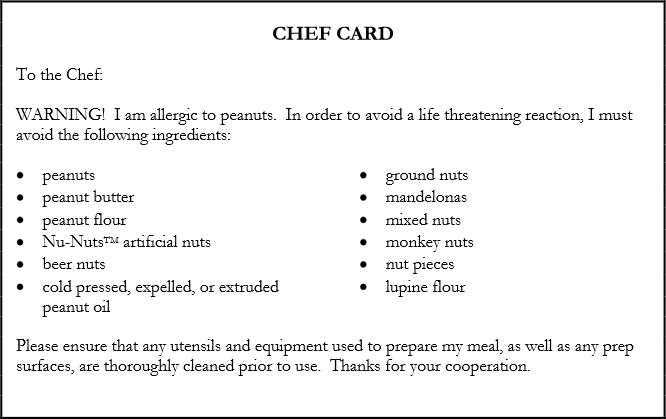Peanut Allergy
Children with allergies to peanuts may have life threatening reactions to extremely small quantities of peanut products. This food allergen is very potent, and can sensitize infants even in the first days of life. Most (about 85%) of peanut allergic infants will demonstrate marked symptoms on their first observed exposure to peanuts. This is most unusual. Usually a period of exposure is required before an individual can become “sensitized” to a food allergen. In some recent studies, about half of 23 breast feeding mothers were able to secrete trace amounts of peanut allergen in their breast milk, after they had eaten a normal amount (about 1/3 cup) of dry roasted peanuts. The peanut allergen was detected in sequential samples of bre ast milk within two hours after eating the peanuts, and could be found up to six hours later. If one of these mothers had a child who was genetically predisposed to develop allergy, it is possible that this is how they would first receive their “sensitizing dose”. Another possibility is that these infants become sensitized from coming into contact with low levels of environmental peanut butter that can appear in any household with messy toddlers. In either case, once sensitized, the infants are “primed” for their first peanut reaction. Just a small spoonful of peanut butter, is usually enough to trigger a violent reaction.
Once established, a peanut allergy can be very significant. Extreme reactions can be life threatening. At this point, the only effective treatment is STRICT AVOIDANCE. The many names of foods that include peanut allergen are listed on the back of this form. Parents who care for peanut allergic children need to read the ingredients label of everything that they eat. If it does not have a label, don’t eat it. Also, they need to visually inspect packaged foods before serving them. If it looks like it contains nuts, don’t eat it. Peanuts are often found in African, Mexican, Chinese, Thai and several other ethnic foods. They are ofte n found as an additional ingredient in baked goods, candies, ice creams and frozen yogurts. Peanut protein has been added to some forms of potato chips. Even if it sounds very unlikely, you must still READ THE LABEL.
When dining in a restaurant, use the printable CHEF CARD from the bottom of this page. The waiter and the cook should take it into the kitchen for reference. It will inform them of the ingredients to avoid and to clean the cooking utensils and any prep surfaces prior to assembling the meal. Make sure they return the card to you when your food is served. Then visually inspect the food. If the dish you have ordered still looks like it may contain peanuts, ask again before you allow your child to eat it. If a mistake has been made on your order, hold onto the incorrect meal while they prepare you a fresh one. This will ensure that the peanut product is not simply picked off from the first dish
If you have a peanut allergic child at home, you need to avoid peanut butter or peanuts in the pan try. Any peanuts for the personal use of other family members should be carefully secured, away from the other daily food. Avoid using peanut oil if you do not know its manufacturing source. Heat pressed oil, (like the commercial Planter’s Peanut Oil), appears to be safe and contains no peanut allergen. Cold expressed, or expelled, or extruded peanut oils will contain variable amounts of allergen.
If you do not know the source, then don’t eat it. Peanut allergic patients have reacted to lupine flour, which is added to some European baked products and pasta. We recommend that you avoid products containing lupine flour.
Some skin preparations will contain Arachis Oil which is derived from peanuts. W e recommend that you avoid the skin care products with the name arachis in the ingredients list .
There has been much said recently about creating “peanut free” zones in airplanes, schools, and child care centers. Peanuts are still being served on many flights. Parents of peanut allergic children should ask the flight attendants to avoid any peanuts within their row of travelers. We believe that it is rare for peanut allergic patients to have symptoms from airborne peanut allergen in the ventilation of cross – country flights. Schools and childcare centers should have an emergency plan completed by parent and health care provider. Even if they are a “peanut free” center, they will need to have a plan since peanuts are sometimes hidden in other foods. Peanuts and peanut butter should be avoided as an ingredient in art projects (i.e. peanut butter bird feeders), and as a packaged food for field trips. At meal times, it is important to avoid cross contamination from other children’s food. Wash and sanitize all cutting surfaces and knives after handling peanut butter. Wash hands thoroughly. Residual peanut butter on surfaces can transfer to “peanut free” foods and cause an allergic reaction.
Like the Boy Scout Motto, a peanut allergic patient must always “Be Prepared”. Unlike other food allergies, only 20 percent of peanut allergic children will ever “outgrow” their sensitivity. The rest have to deal with it every day of their lives. Even with careful attention to food ingredients, an accidental peanut exposure seems to occur about every 2 to 5 year s for most of our patients. 1 in 5 reactions happen in the school or day care setting. All peanut allergic patients should have a written plan for emergency care. If their reaction is severe, they should have adrenalin and antihistamines on hand. This same plan should accompany them if they are cared for outside the home.
At this point you might be asking, “What can I feed this child?” As an alternative to peanut butter, you can use other spreads: bean dip, hummus, refried beans, cheese spreads, se same tahini, soybean butter, cashew butter, or almond butter. To use in baked products or as toppings consider seeds (sunflower or sesame), raisins, nuts and nut butters (almond, cashew, soy nuts, walnuts, pecans, macadamia nuts). Protein replacements ca n be chicken, turkey, beef, TOFU, beans, tuna, hot dogs, yogurt, and cheese. Keep in mind that nuts, seeds, raisins and very small hot dogs can cause choking. Serve only to children with good chewing skills. Also, some individuals with peanut allergy need to avoid other legumes or even tree nuts. If you are unsure about these alternatives and how they would fit with your other food allergies, ask your health care provider.



